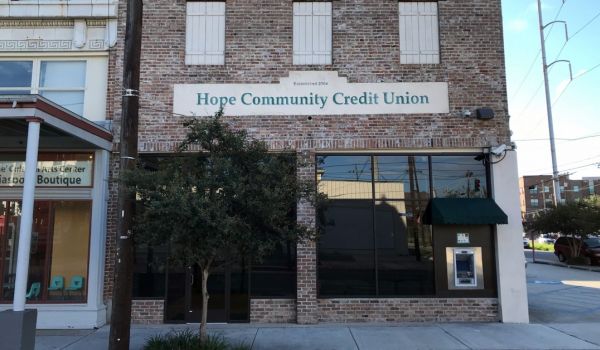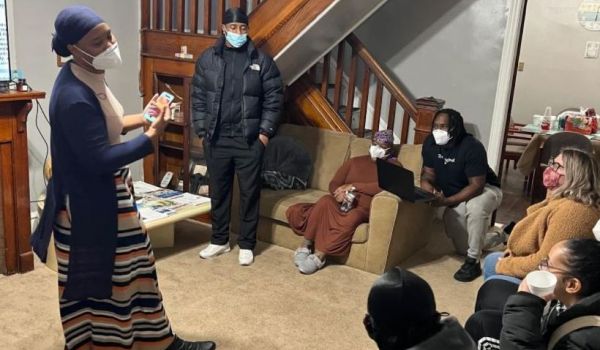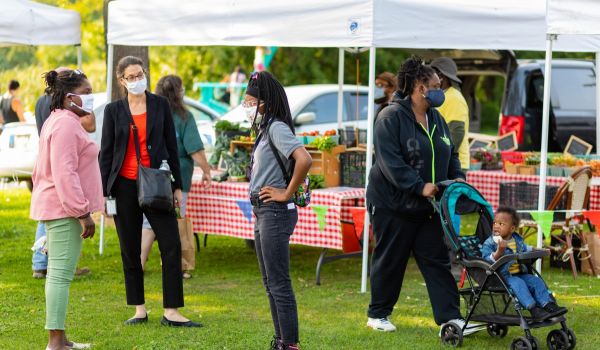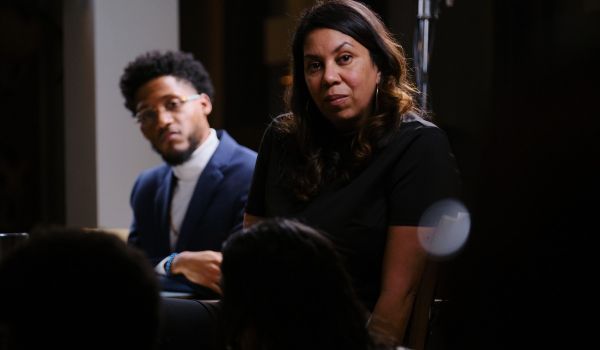Black Financial Empowerment: The Long, Hard Road
Recently, Netflix made national news by committing $100 million in investments to Black financial institutions, including Hope Credit Union, a multi-state Community Development Financial Institution headquartered in Jackson, MS. In these extracts from Democratizing Finance: Origins of the Community Development Financial Institutions Movement, author and veteran CDFI activist Clifford Rosenthal highlights efforts to bring capital to Black communities, from the Civil War, through the Great Depression, and the Civil Rights movement. It is a history of philanthropic intentions gone astray, shattered dreams, but also resilience in the face of crushing poverty and segregation. The “CDFI era” has brought new hope, even—especially—amid pandemic and economic collapse.
The Civil War and Freedman’s Bank: A Dream Betrayed
Freedman’s Savings and Trust Company (often referred to as Freedman’s Bank) was chartered by the United States Congress—but in fact, it was privately owned, and Congress viewed it as a philanthropic effort. The federal government retained the right to examine the bank’s books. Fifty trustees were charged with oversight, and ownership resembled a depositor-owned mutual institution. Whites controlled it, and initially, few blacks were employed, although this changed later.
The bank grew explosively. Originally headquartered in New York City, it later moved to Washington, DC From 1865 until 1871, more than 30 branches were organized in more than 30 branches in 17 states and the District of Columbia. It has been estimated that in its brief existence, some 70,000 depositors opened and closed accounts in the bank, amassing more than $57 million.
Depositors were issued passbooks, some inscribed with moral instructions “on temperance, frugality, economy, chastity, the virtues of thrift and savings.” More problematic, some passbooks carried images of President Lincoln and other high federal officials, giving the impression of government backing for the bank. “It is certain,” Frederick Douglass wrote, “that the depositors in this institution were led to believe that as Congress had chartered it and established its headquarters at the capital, the government in some way was responsible for the safe keeping of their money.”
Freedman’s Savings and Trust was chartered as a vehicle for saving—capital accumulation, not credit. But a charter change in 1870 allowed the bank to enter real estate lending. Disaster followed. Precious few of the loans flowed to African American depositors: Instead, “white managers often misused funds, including borrowing funds from the bank and not repaying them.” Freedman’s incurred losses on loans made with insufficient or nonexistent security, loans made to insiders, and speculative investments. The beneficent, philanthropic paternalism of some of its trustees was overwhelmed by those interested in personal gain.
“Married to a Corpse”
By March 1874, the bank was in desperate straits. It solicited Frederick Douglass to become its president, a source of no small pride for him: “I could not help reflecting on the contrast between Frederick the slave boy… and Frederick—president of a bank counting its assets by millions.” Douglass saw “the row of its gentlemanly and elegantly dressed colored clerks, with their pens behind their ears and buttonhole bouquets in their coat-fronts, and felt my very eyes enriched.… The whole thing was beautiful. … I felt like the Queen of Sheba when she saw the riches of Solomon.”
He would soon come to regret his awestruck reaction. “The more I observed and learned, the more my confidence diminished.” He found discrepancies in the books and evidence of dishonesty of employees. In vain, he loaned the bank $10,000 of his own money to buttress confidence in the bank. Humiliated by his experience, Douglass had come to realize that he had been brought in to raise the dead.
The fact is, and all investigation shows it, that I was married to a corpse. The fine building, with its marble counters and black walnut finishings, was there, as were the affable and agile clerks and the discreet and colored cashiers but the life, which was the money, was gone, and I found that I had been placed there with the hope that by ‘some drugs, some charms, some conjuration, or some mighty magic,’ I would bring it back.
He did not. He could not. On June 20, 1874, Congress passed an act directing the appointment of commissioners to close the bank.
There was no deposit insurance. The collapse of the bank inflicted great damage not only to individual depositors, some of whom pleaded for decades to be reimbursed, but also to the pillars of Black society: “When the Freedman’s Bank closed, many of these institutions, particularly the churches and beneficial societies, had to suspend or drastically curtail vital services, thus adding to the social and economic woes of the African American community.” Frederick Douglass was devastated, and he felt that his reputation had been grievously harmed. He wrote in his autobiography that his connection with the bank “has brought upon my head an amount of abuse and detraction greater than any encountered in any other part of my life.”
“Not even ten additional years of slavery”
It is hard to imagine a more bitter, anguished postmortem than that written by W. E. B. Du Bois in 1903.
Morally and practically, the Freedmen’s Bank was part of the Freedmen’s Bureau, although it had no legal connection with it… This banking institution had made a remarkable start in the development of that thrift among black folk which slavery had kept them from knowing. Then in one sad day came the crash—all the hard-earned dollars of the freedmen disappeared; but that was the least of loss—all the faith in saving went too, and much of the faith in men; and that was a loss that a Nation which to-day sneers at Negro shiftlessness has never yet made good. Not even ten additional years of slavery could have done so much to throttle the thrift of the freedmen as the mismanagement and bankruptcy of the series of savings banks chartered by the Nation for their especial aid.
The Great Depression: Fighting for “Economic Emancipation” in Brooklyn
Facing outright segregation in the South and less formalized exclusion in the north, African Americans found credit unions a desperately needed alternative. As Jessica Gordon Nembhard has written, “The Great Depression probably saw the rise of more African American‒owned cooperatives than any other period in United States history.” North Carolina was the epicenter of organizing rural credit unions and other cooperatives.
African American credit unions emerged in the cities of the North as well, primarily among churches and civic associations. The thirties were “a period in history when black men felt themselves reverting to a status of slavery from which they had been emancipated only a few generations ago. The formation of our Association [in Brooklyn, NY] was the answer to this great socio-economic dilemma,” wrote Clyde Atwell, a longtime official of the Paragon Federal Credit Union, which was founded by Caribbean immigrants. In the North, African Americans did not have to deal with the legacy of sharecropping, but rather with economic abuses magnified by their racial and cultural status: “Prices were high. Schemes for fleecing the blacks were rampant. Being poor but ambitious, our people were most vulnerable,” Atwell wrote. “With an eye of self-preservation some ventured their life savings in the purchase of two- family brownstones. In many instances the intended investment became a misfortune. Being limited in knowledge on matters pertaining to real estate, the homes were soon reclaimed by the very brokers who sold them.”
It was this dire situation that led to the organizing of the credit union. As a founder of the Paragon Association, the credit union’s sponsor, wrote: “July 18, 1939 marks the day the black historians must emphasize as the beginning of the economic emancipation of the blacks in Brooklyn, New York.” In Brooklyn’s Bedford-Stuyvesant neighborhood, the “Paragon was founded by poor, dejected and deprived people. They were stalled up by poverty. The order of the day was no work, no money, and no hope. Self-sufficiency meant scheming to get one good meal sometime during the day.”
Credit Unions and the Civil Rights Struggle: “We Stood in the Door”
Carol Zippert, a longtime Civil Rights and cooperative leader, was introduced to the cooperative movement in the early 1960s through the efforts of Father A. J. McKnight in Lafayette, LA. He was, Zippert recalled, “the first Black priest to come to our church parish, which was all Black; the churches were segregated as well.” With the literacy classes McKnight organized came engagement with the civil rights movement for high-school students like Zippert: “We were the same ones that would go out to integrate places, like the lunch counters at the five and dime stores. [We learned that] these were not our restaurants, our hotels; we don’t have any businesses. So, Father McKnight got us talking about our community assets.” Families saved for three years to raise capital, $300 each—“it was a lot of money in the early 60s, so people would pay about $2 a month, towards their $300.” At Father McKnight’s church, they organized the St. Paul Federal Credit Union. In 1975, aided by the Federation of Southern Cooperatives, Zippert helped to organize the Federation of Greene County Employees Federal Credit Union (FOGCE FCU) in Alabama.
When the credit union later ran afoul of the regulators because of high loan delinquency, the community banded together—physically and financially—to save their institution. When examiners from the National Credit Union Administration came to shut down FOGCE, she said, “We stood in the door. We had the people, we stood in the door, and we blocked it. We got the whole community involved in raising the money. Even the school system. Because at that point in Greene County, we had a black superintendent and a black school board.”
Elsewhere in Alabama, Eddie Ayers, a teacher and the son of sharecroppers, joined with six other people to organize the Demopolis Federal Credit Union in 1966. He recalled the inextricable link between the legacy of slavery and economic retaliation against civil rights activists. “People were getting put off the land, they had to move because they were participating in the demonstrations in the sixties. And the idea was born that we needed a credit union.” Like many other credit unions in the South, Ayers said, “We had no place to house a credit union. The treasurer was a barber, he owned a barber shop, so he carried the books to the barber shop and that’s where we operated right out of the barber shop.” After years of being denied credit by banks to start small businesses, “with the coming of the credit union I could feel a change, and I could see it that it was a different attitude.”
The birth of the CDFI Fund brought hope to many small, Black, and other minority credit unions that hoped for infusions of capital. But especially in its early years, the CDFI Fund’s extensive, demanding application put its resources out of reach for many grassroots organizations that lacked the capacity to compete for funds—an unfortunate instance of disparate impact. Democratizing Finance takes the story of community development finance from the early struggles to establish the CDFI Fund through its first two decades, years marked by the Great Recession, the growth of the fund under President Obama, and its bipartisan survival despite the opposition of the Trump Administration.
Democratizing Finance: Origins of the Community Development Financial Institutions Movement is available in print and e-book formats from multiple online booksellers. To order, please visit: www.cliffrosenthal.com.
Clifford Rosenthal is the author of “Democratizing Finance: Origins of the Community Development Financial Institutions Movement.” He is a nationally and internationally recognized innovator, advocate, and developer of programs to provide financial access for low-income and underserved people. He has worked and volunteered for more than 40 years in the cooperative movement, initially in organizing food co-ops for Native American and migrant farmworker organizations, and for more than 30 years in the credit union movement. From 1980 through 2012, Rosenthal managed the National Federation of Community Development Credit Unions, the association of more than 200 credit unions serving low-income and minority communities (now known as Inclusiv). In 2012, he was recruited to establish the Office of Financial Empowerment at the newly created federal Consumer Financial Protection Bureau.

_920_481_80.jpg)














